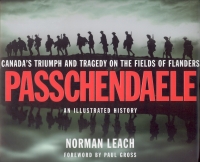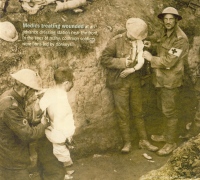| ________________
CM . . .
. Volume XV Number 6. . . .November 7, 2008 
 |
Passchendaele: Canada's Triumph and Tragedy on the Fields of Flanders: An Illustrated History.
Norman Leach.
Regina, SK: Coteau Books, 2008.
48 pp., hardcover, $19.95.
ISBN 978-1-55050-399-9.
Subject Headings:
Ypres, 3rd Battle of, Ieper, Belgium, 1917.
Canada. Canadian Army-History-World war, 1914-1918.
Ypres, 3rd battle of, Ieper, Belgium, 1917-Pictorial works.
Grades 7 and up / Ages 12 and up.
Review by Val Ken Lem.
***½ /4
|
| |
|

excerpt:
In capturing 1,850 metres of mud, the Allies suffered 32,000 casualties, yet [British Field-Marshall] Haig was even more convinced that success was within his reach. He ordered the continuous shelling of German positions throughout early August. The torrential rains turned the battlefield to a sea of mud. Broken trees littered the landscape, and as shelling churned the ground, bodies of men killed in earlier battles surfaced. Troops became accustomed to the foul smell of rotting flesh, and the rats infesting the trenches grew fat and bold feasting on human remains.
Norman Leach is a talented military historian who served as historical advisor on the Canadian war film Passchendaele that was written, directed and produced by Paul Gross who is also a star of the film and author of the preface to this work.
The Third Battle of Ypres in Belgium began in June of 1917. Months and 100,000 Allied casualties later, the Passchendaele Ridge remained in German hands. In late October and early November, Canadian troops managed to do what the British, Australian and New Zealand troops could not: they drove the Germans from their three-year occupation of Passchendaele. Almost 16,000 Canadians were killed or wounded in the campaign, with more than 1,000 lost and never recovered from the muddy fields of Flanders. In addition to highlighting the valour and heroism of the Canadian troops, the battle clearly illustrates the tragic horrors of trench warfare that characterized World War I, and it also demonstrated the importance of Canadian innovations in leadership and troop training.
 Leach focuses on the battle for Passchendaele but includes important background information about World War I and Canadian participation leading up to and after the infamous battle. He makes excellent use of diary entries to convey firsthand accounts of conditions encountered by soldiers. Some diary entries or quotations from memoirs by Allied soldiers of many ranks and some German soldiers are also included as sidebars to the text. The book is very pleasantly designed with topics like "Training for the Western Front" or "Canadian Innovation on the Western Front" or "October 27-29, 1917" developed on double page spreads accompanied with, on average, six archival photographs or other photographs plus additional illustrative material like a map or image of an artefact. The photographs are reproduced in a variety of tones: sepia, purplish, greenish which helps to make each one stand apart from the others on the page. Other images, such as posters advocating the purchase of Victory Bonds, are reproduced in full colour. The illustrative material includes informative captions. The images are, at times, extremely graphic and reinforce the horrors of the war as described in the text. Numerous pictures depict stretcher-bearers carrying wounded or dead soldiers, and before and after aerial views of Passchendaele give another perspective on the total desolation of the town and surrounding region following months of Allied bombardment.
Leach focuses on the battle for Passchendaele but includes important background information about World War I and Canadian participation leading up to and after the infamous battle. He makes excellent use of diary entries to convey firsthand accounts of conditions encountered by soldiers. Some diary entries or quotations from memoirs by Allied soldiers of many ranks and some German soldiers are also included as sidebars to the text. The book is very pleasantly designed with topics like "Training for the Western Front" or "Canadian Innovation on the Western Front" or "October 27-29, 1917" developed on double page spreads accompanied with, on average, six archival photographs or other photographs plus additional illustrative material like a map or image of an artefact. The photographs are reproduced in a variety of tones: sepia, purplish, greenish which helps to make each one stand apart from the others on the page. Other images, such as posters advocating the purchase of Victory Bonds, are reproduced in full colour. The illustrative material includes informative captions. The images are, at times, extremely graphic and reinforce the horrors of the war as described in the text. Numerous pictures depict stretcher-bearers carrying wounded or dead soldiers, and before and after aerial views of Passchendaele give another perspective on the total desolation of the town and surrounding region following months of Allied bombardment.
Leach concludes the volume with a brief discussion of Canadian activities in the last year of the war, a reassessment of Field-Marshall Haig, notes on the "Canadian Route of Remembrance" that links war cemeteries in Belgium, and the story of a soldier whose remains were uncovered a few years ago and identified by use of modern forensic techniques. The last image is a scene from the movie Passchendaele, and it looks as authentic as any of the archival images in the book.
This brief volume will stand alone, but it is best read or used in conjunction with some additional works that provide fuller background information on Canada and the First World War and perhaps more details about how the Canadian forces were organized into battalions, divisions, etcetera, since no glossary is provided to explain these terms. Passchendaele makes a very good tie-in to the movie that will be released in theatres this fall.
Highly Recommended.
Val Ken Lem is the Collection Evaluation Librarian at Ryerson University, in Toronto, ON. His grandfather, Alfred Pilon, was a Canadian veteran of both World Wars.

To comment
on this title or this review, send mail to cm@umanitoba.ca.
Copyright © the Manitoba Library Association. Reproduction for personal
use is permitted only if this copyright notice is maintained. Any
other reproduction is prohibited without permission.
NEXT REVIEW |
TABLE OF CONTENTS FOR THIS ISSUE
- November 7, 2008.
AUTHORS |
TITLES |
MEDIA REVIEWS |
PROFILES |
BACK ISSUES |
SEARCH |
CMARCHIVE |
HOME |

 Leach focuses on the battle for Passchendaele but includes important background information about World War I and Canadian participation leading up to and after the infamous battle. He makes excellent use of diary entries to convey firsthand accounts of conditions encountered by soldiers. Some diary entries or quotations from memoirs by Allied soldiers of many ranks and some German soldiers are also included as sidebars to the text. The book is very pleasantly designed with topics like "Training for the Western Front" or "Canadian Innovation on the Western Front" or "October 27-29, 1917" developed on double page spreads accompanied with, on average, six archival photographs or other photographs plus additional illustrative material like a map or image of an artefact. The photographs are reproduced in a variety of tones: sepia, purplish, greenish which helps to make each one stand apart from the others on the page. Other images, such as posters advocating the purchase of Victory Bonds, are reproduced in full colour. The illustrative material includes informative captions. The images are, at times, extremely graphic and reinforce the horrors of the war as described in the text. Numerous pictures depict stretcher-bearers carrying wounded or dead soldiers, and before and after aerial views of Passchendaele give another perspective on the total desolation of the town and surrounding region following months of Allied bombardment.
Leach focuses on the battle for Passchendaele but includes important background information about World War I and Canadian participation leading up to and after the infamous battle. He makes excellent use of diary entries to convey firsthand accounts of conditions encountered by soldiers. Some diary entries or quotations from memoirs by Allied soldiers of many ranks and some German soldiers are also included as sidebars to the text. The book is very pleasantly designed with topics like "Training for the Western Front" or "Canadian Innovation on the Western Front" or "October 27-29, 1917" developed on double page spreads accompanied with, on average, six archival photographs or other photographs plus additional illustrative material like a map or image of an artefact. The photographs are reproduced in a variety of tones: sepia, purplish, greenish which helps to make each one stand apart from the others on the page. Other images, such as posters advocating the purchase of Victory Bonds, are reproduced in full colour. The illustrative material includes informative captions. The images are, at times, extremely graphic and reinforce the horrors of the war as described in the text. Numerous pictures depict stretcher-bearers carrying wounded or dead soldiers, and before and after aerial views of Passchendaele give another perspective on the total desolation of the town and surrounding region following months of Allied bombardment.